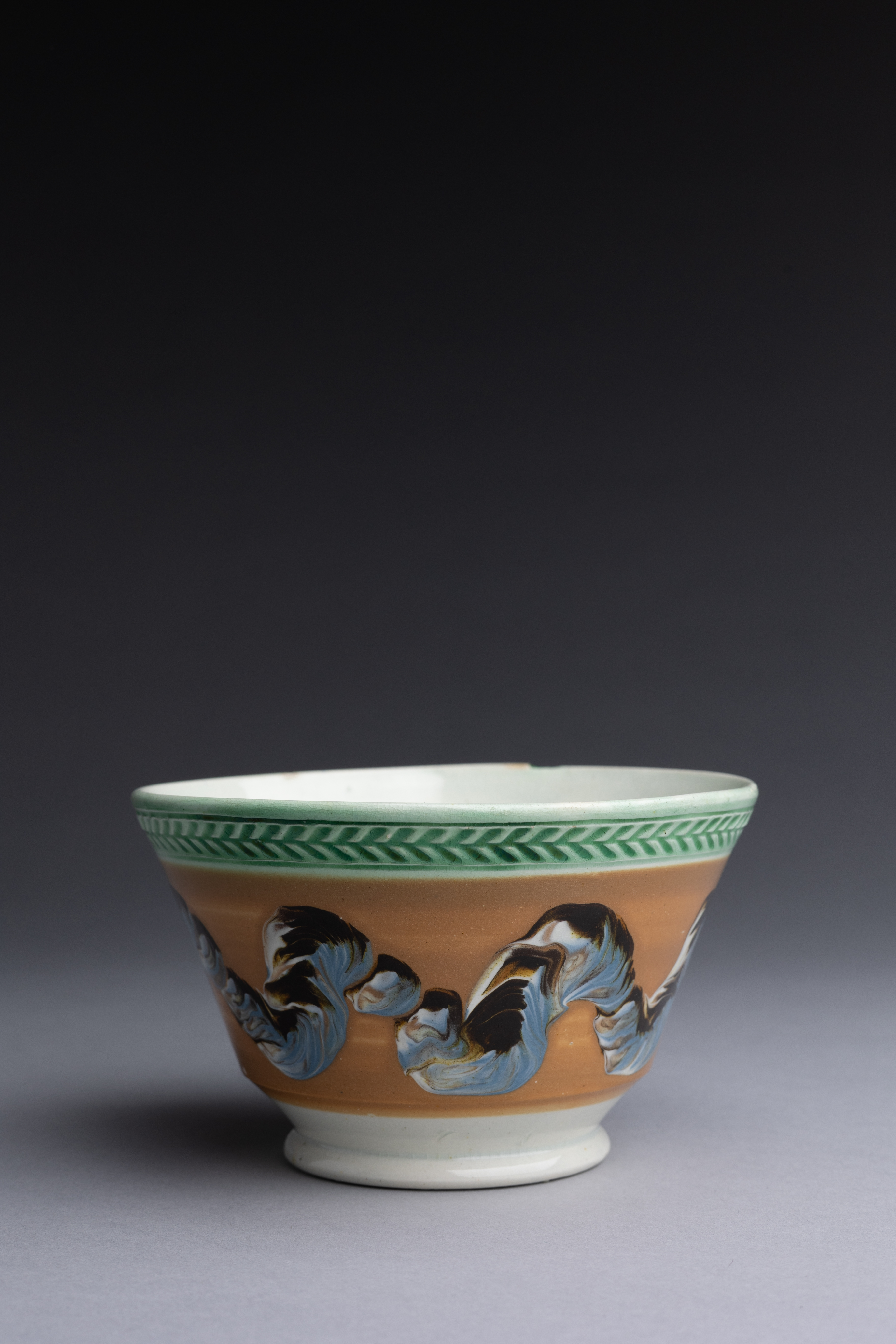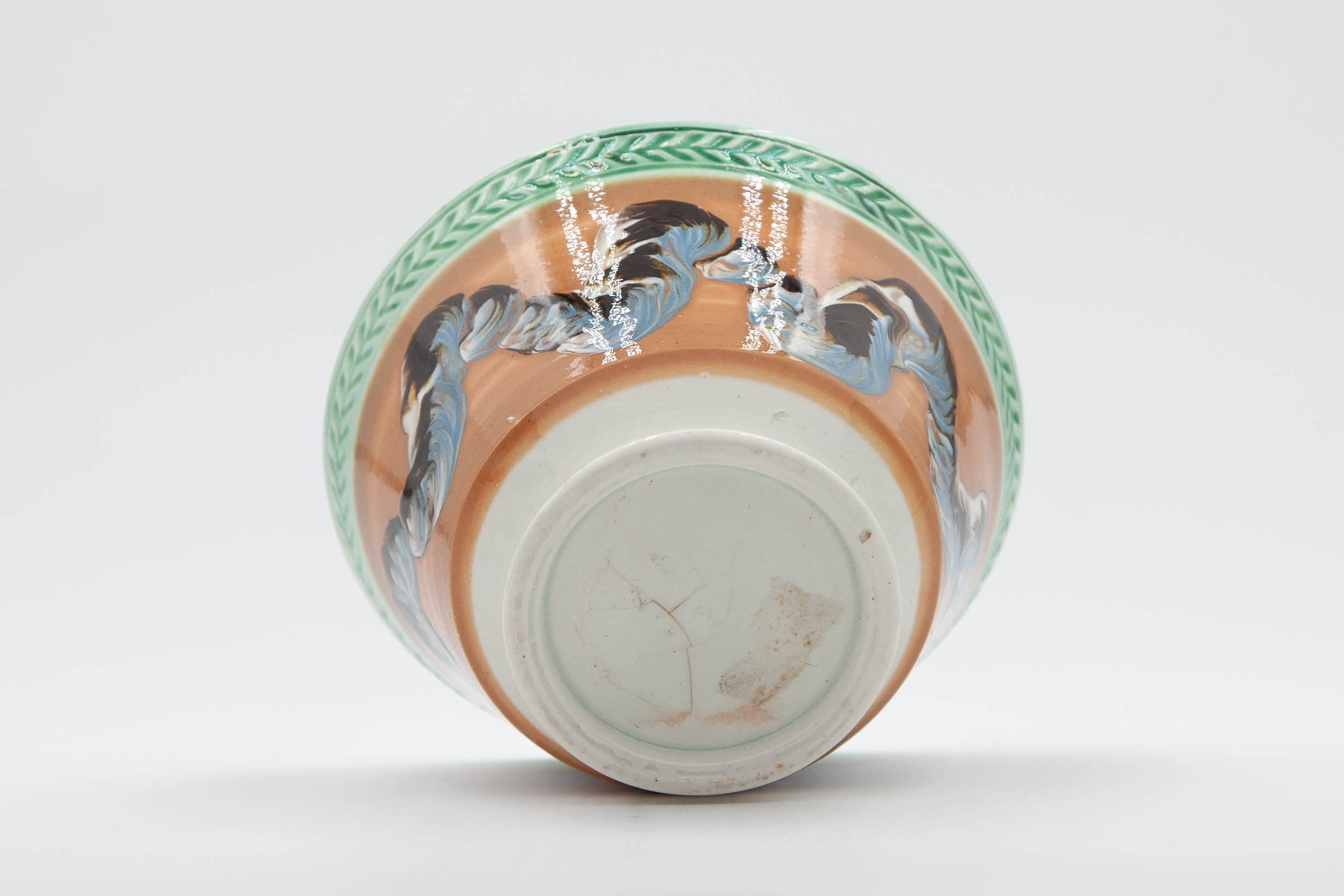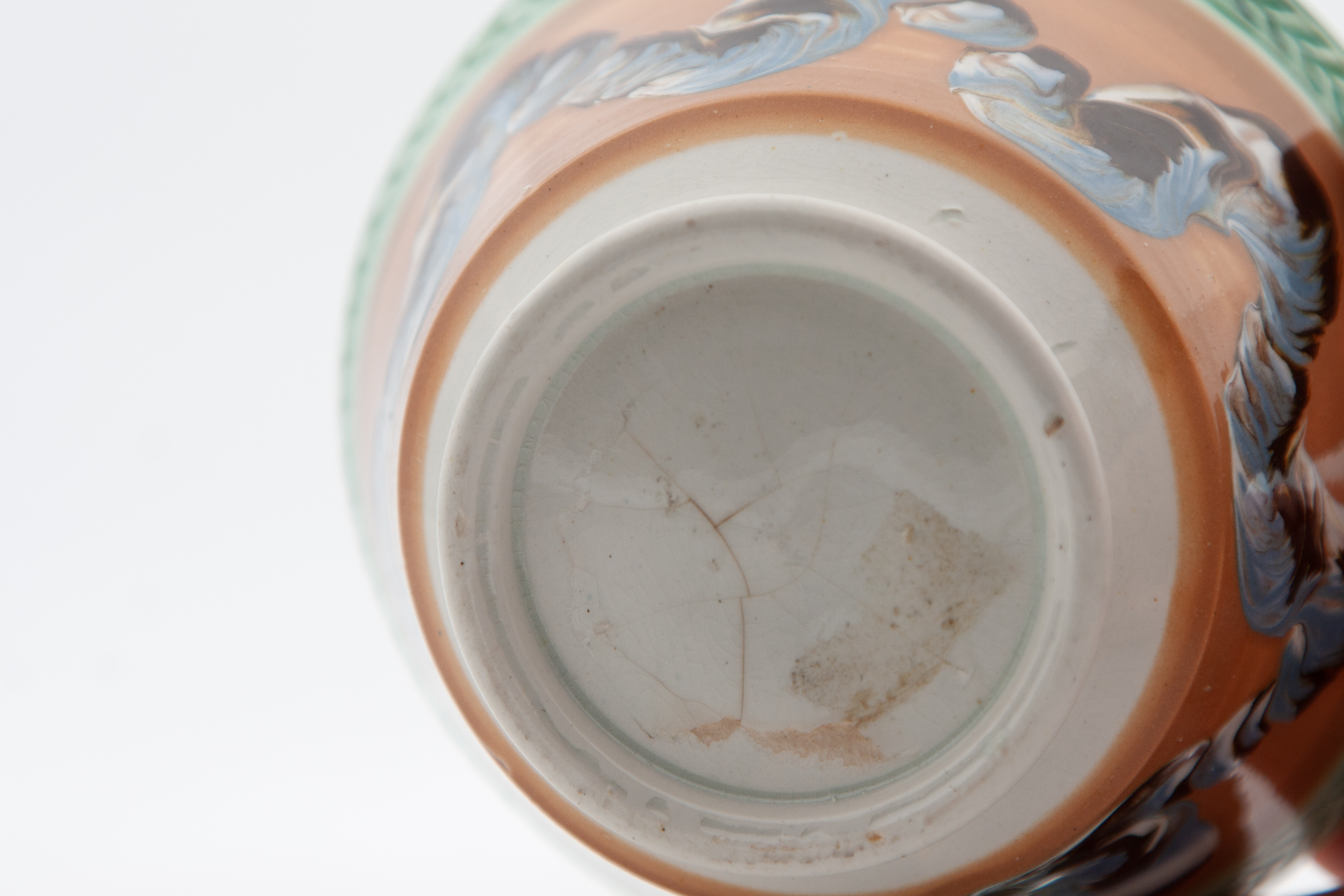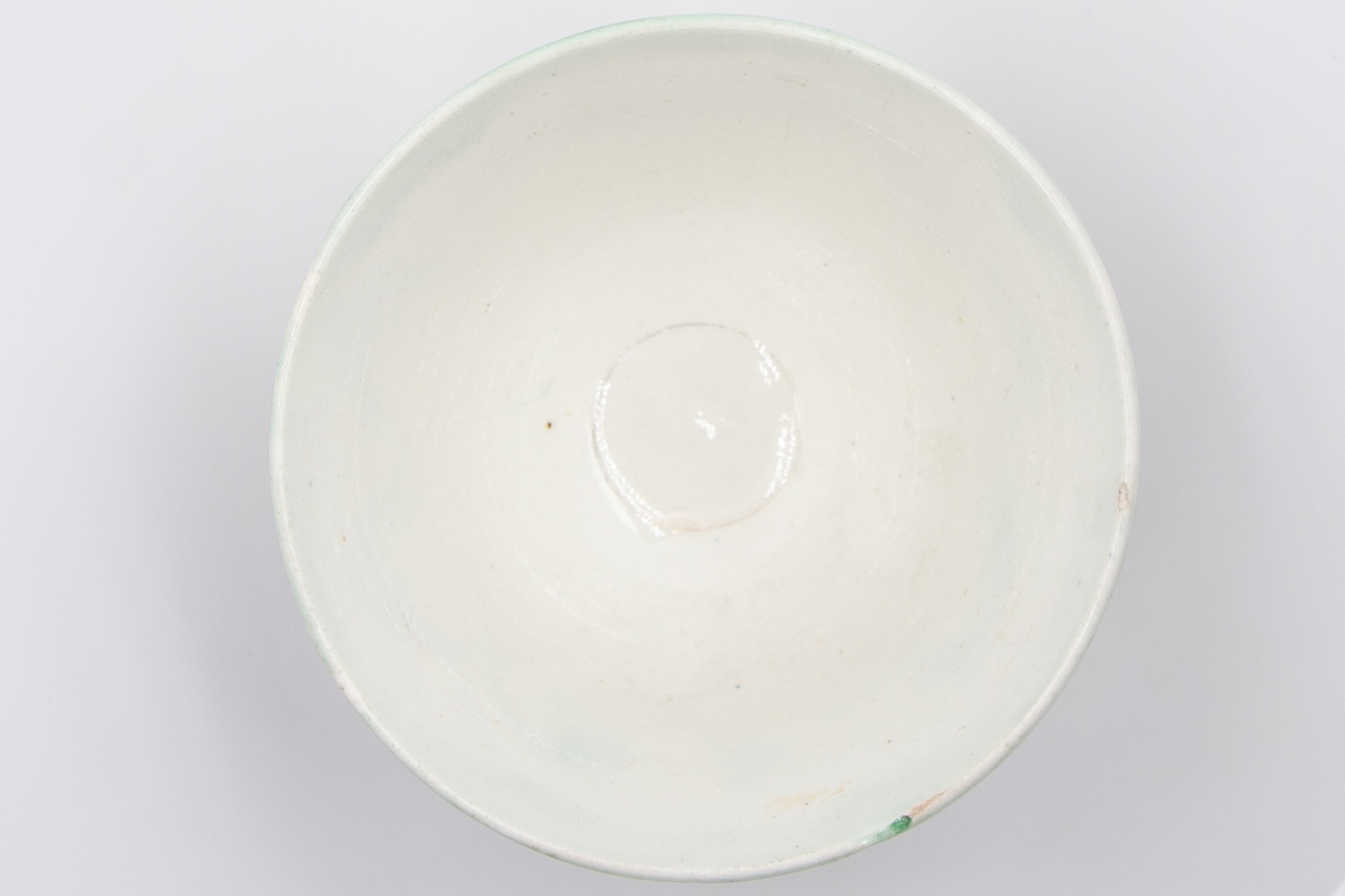Developed in Staffordshire in the late 18th century, dipped wares utilized colored liquid clay slips to create surprisingly modern abstract and geometric motifs. This small waste bowl features a cable design with marbled colors of dark brown, blue, and white slip on an orange ground. The bowl’s rim has a rouletted band of chevrons lightly glazed in green. The bright color palette of this bowl dates it to an earlier period of production, circa 1820. Later dipped wares have much more subdued colors.
Developed in Staffordshire in the late 18th century, dipped wares utilized colored liquid clay slips to create surprisingly modern abstract and geometric motifs. This small waste bowl features a cable design with marbled colors of dark brown, blue, and white slip on an orange ground. The bowl’s rim has a rouletted band of chevrons lightly glazed in green. The bright color palette of this bowl dates it to an earlier period of production, circa 1820. Later dipped wares have much more subdued colors.
Essay
Dipped wares were the cheapest decorated hollow wares available on the market in the late 18th and 19th centuries, according to ceramics scholar George L. Miller (Miller 1991). At the inception of dipped wares’ production in the 1780s, these pieces cost 60% more than undecorated wares (likely due to novelty and a nebulous manufacturing process). By the mid-19th century, however, prices dropped to only 8% more than their plain counterparts. Dipped wares were often used in bars, where the rate of breakage was likely quite high, and a diminished supply could be restocked rather inexpensively. Indeed, dipped wares are prevalent today mainly as pottery sherds in archaeological excavations; complete vessels are difficult to find because they were often broken and disposed of as a result of their being so inexpensive.
Though dipped wares were produced and sold cheaply, they are emblematic of a combination of unique artistry and a meticulously developed manufacturing process. The aesthetic balances randomness and order. Dipped wares were developed and produced in Staffordshire, England in the midst of the Industrial Revolution, a period which saw a decrease in agrarian-based economies and an increase in urbanization that led to the rise of factories and mass-production. Creation processes previously undertaken by artists and craftsmen passed to factory workers, who worked to turn out hundreds of pieces daily to supply market demands. Dipped wares represent this transition: a melding of Industrial Revolution mechanization and the previous generation of pure craftsmanship.
A mechanized element of this bowl can be seen in the engine-turned rouletted band of green chevrons around the rim. Engine-turning, which can be found on pottery as early as the 1770s, was a process that was used to create complex and exact geometric designs. Another Industrial Revolution manufacturing process exemplified by this bowl was the use of molds to reproduce vessel sizes and shapes in large quantities.
After the vessels were formed and dried, an artist would apply the unique designs. The cable pattern on this bowl was created using a multi-chambered pot. The potter filled each chamber with a different colored slip, then poured the mixture directly on the vessel to create the desired design. Artists used the multi-chambered slip pot to create cable designs, such as the one on our bowl, and the so-called “cat’s eye” design, which featured just a single drop of the slip mixture rather than one continuous cable. The overall look was controlled by the artist to a point, however the finished design was subject to the interaction of the different slips.
Dipped wares were sort of the “everyman’s” ceramic, but their global impact cannot be underestimated. Exported in great numbers to the United States, dipped pottery inspired American artisans to produce their own pieces. As aforementioned, dipped ware sherds are abundant in archaeological excavations in the States. Dipped wares exhibit new artistic innovations and ways of manufacturing as well as the impact of trade and global inspiration.
BT
Condition
The bowl is in very good condition, with two tiny chips to the rim each measuring approximately 0.2 cm in length. The underside of the base has some glaze flaking. There is a hairline circular crack in the well of the bowl.
For a detailed condition report, please contact us.
Curator’s Note
It is important to note that today all dipped wares are referred to as “mochaware,” however that term historically referred specifically to pieces decorated with a dendritic design (see this piece in our collection).
References
Carpentier, Donald and Jonathan Rickard. “Slip Decoration in the Age of Industrialization.” Ceramics in America, ed. Robert Hunter. Burlington: University of Vermont Press, 2001.
Miller, George L. “A Revised set of CC Index Values for Classification and Economic Scaling of English Ceramics from 1787 to 1880,” Historical Archaeology, Vol 25, no. 1 (1991): 1-25.
Rickard, Jonathan. Mocha and Related Dipped Wares, 1770-1939. University Press of New England, 2006.
Dipped wares were the cheapest decorated hollow wares available on the market in the late 18th and 19th centuries, according to ceramics scholar George L. Miller (Miller 1991). At the inception of dipped wares’ production in the 1780s, these pieces cost 60% more than undecorated wares (likely due to novelty and a nebulous manufacturing process). By the mid-19th century, however, prices dropped to only 8% more than their plain counterparts. Dipped wares were often used in bars, where the rate of breakage was likely quite high, and a diminished supply could be restocked rather inexpensively. Indeed, dipped wares are prevalent today mainly as pottery sherds in archaeological excavations; complete vessels are difficult to find because they were often broken and disposed of as a result of their being so inexpensive.
Though dipped wares were produced and sold cheaply, they are emblematic of a combination of unique artistry and a meticulously developed manufacturing process. The aesthetic balances randomness and order. Dipped wares were developed and produced in Staffordshire, England in the midst of the Industrial Revolution, a period which saw a decrease in agrarian-based economies and an increase in urbanization that led to the rise of factories and mass-production. Creation processes previously undertaken by artists and craftsmen passed to factory workers, who worked to turn out hundreds of pieces daily to supply market demands. Dipped wares represent this transition: a melding of Industrial Revolution mechanization and the previous generation of pure craftsmanship.
A mechanized element of this bowl can be seen in the engine-turned rouletted band of green chevrons around the rim. Engine-turning, which can be found on pottery as early as the 1770s, was a process that was used to create complex and exact geometric designs. Another Industrial Revolution manufacturing process exemplified by this bowl was the use of molds to reproduce vessel sizes and shapes in large quantities.
After the vessels were formed and dried, an artist would apply the unique designs. The cable pattern on this bowl was created using a multi-chambered pot. The potter filled each chamber with a different colored slip, then poured the mixture directly on the vessel to create the desired design. Artists used the multi-chambered slip pot to create cable designs, such as the one on our bowl, and the so-called “cat’s eye” design, which featured just a single drop of the slip mixture rather than one continuous cable. The overall look was controlled by the artist to a point, however the finished design was subject to the interaction of the different slips.
Dipped wares were sort of the “everyman’s” ceramic, but their global impact cannot be underestimated. Exported in great numbers to the United States, dipped pottery inspired American artisans to produce their own pieces. As aforementioned, dipped ware sherds are abundant in archaeological excavations in the States. Dipped wares exhibit new artistic innovations and ways of manufacturing as well as the impact of trade and global inspiration.
BT
The bowl is in very good condition, with two tiny chips to the rim each measuring approximately 0.2 cm in length. The underside of the base has some glaze flaking. There is a hairline circular crack in the well of the bowl.
For a detailed condition report, please contact us.
It is important to note that today all dipped wares are referred to as “mochaware,” however that term historically referred specifically to pieces decorated with a dendritic design (see this piece in our collection).
Carpentier, Donald and Jonathan Rickard. “Slip Decoration in the Age of Industrialization.” Ceramics in America, ed. Robert Hunter. Burlington: University of Vermont Press, 2001.
Miller, George L. “A Revised set of CC Index Values for Classification and Economic Scaling of English Ceramics from 1787 to 1880,” Historical Archaeology, Vol 25, no. 1 (1991): 1-25.
Rickard, Jonathan. Mocha and Related Dipped Wares, 1770-1939. University Press of New England, 2006.
This item ships free to the continental US, and globally for a flat-rate fee of $50.
All objects are packed with utmost care by our team of expert fine art shippers. All items are shipped with parcel insurance.
For more information on our shipping policies, please visit our FAQ Page.







